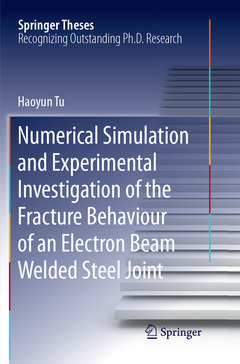In this thesis, the author investigates experimentally and numerically
the fracture behavior of an electron beam welded joint made from
two butt S355 plates. The 2D Rousselier model, the Gurson-Tvergaard-
Needleman (GTN) model and the cohesive zone model (CZM) were
adopted to predict the crack propagation of thick compact tension (CT)
specimens. Advantages and disadvantages of the three mentioned models
are discussed. The cohesive zone model is suggested as it is easy to use
for scientists & engineers because the CZM has less model parameters
and can be used to simulate arbitrary crack propagation. The results
shown in this thesis help to evaluate the fracture behavior of a metallic
material. A 3D optical deformation measurement system (ARAMIS) and
the synchrotron radiation-computed laminography (SRCL) technique
reveal for the first time the damage evolution on the surfaceof the sample
and inside a thin sheet specimen obtained from steel S355. Damage
evolution by void initiation, growth and coalescence are visualized in
2D and 3D laminographic images. Two fracture types, i.e., a flat crack
propagation originated from void initiation, growth and coalescence
and a shear coalescence mechanism are visualized in 2D and 3D images
of laminographic data, showing the complexity of real fracture. In
the dissertation, the 3D Rousselier model is applied for the first time
successfully to predict different microcrack shapes before shear cracks
arise by defining the finite elements in front of the initial notch with
inhomogeneous f0-values. The influence of the distribution of inclusions
on the fracture shape is also discussed. For the analyzed material, a
homogeneous distribution of particles in the material provides the
highest resistance to fracture.




